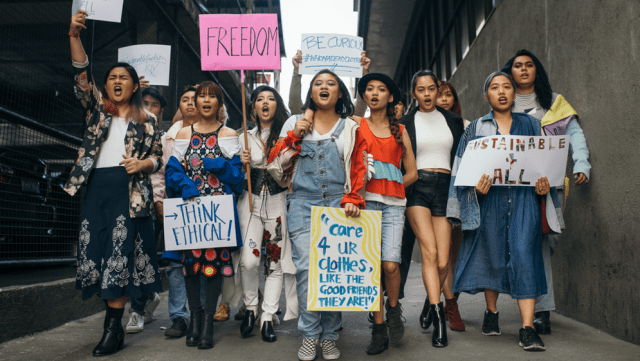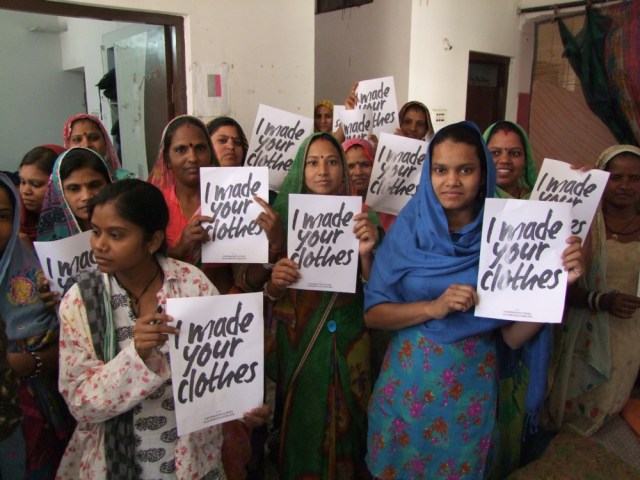How to write a fashion press release that sparks a movement (Case Study)
We speak with Manon Acke, founder of the incredible Two Is A Crowd, about her recent campaign win and the press release that made it all happen
As a fashion PR pro, you’re always looking for that next story that will get the town talking. But how do you write a story that measures up? What assets should be stitched into the press release? How do you tailor-fit your message to the right audience, and the right journo?
Like with most things in life, there's no one-size-fits-all approach. But we've found the next best thing: learning from the experience of someone who's nailed it.
We recently had a conversation with Manon Acke, PR savant, founder of Two Is A Crowd and one of our favorite clients, in which she mentioned the tremendous success she’d had with her latest fashion press release. Obviously, we had to know what made it tick.
In the following article, we break down how Manon put together a bold fashion press release for her client and built an enduring campaign that took Instagram by storm.
On with the show.
Ready to create your own press release?
- Publish and share professional, multimedia press releases
- Translate to 30+ languages in seconds with AI
- Free for your whole team for 14 days, no payment info required

Manon Acke is the founder and creative wild child behind Two Is A Crowd. With experience working with companies like Cosmopolitan Mexico, Marie Claire Belgium, and TBWA, you could argue she’s had more than her fair share of exposure to fashion PR.

Only 24 years young, Manon is a rapidly rising star in the land of public relations, and she's already built a name for herself not only for being a savant of fashion PR, but also for her commitment to making a positive difference in the world, aided by the senior experience of her mentor, Karima Ghozzi.
While working at TBWA, Manon realized that she wanted to work with brands and companies that shared her passion for sustainability and social entrepreneurship.
That’s when she decided to take the bold leap to go out on her own and found Two Is a Crowd, a PR and communications agency where she’d work only with brands that echoed her own drive for creating positive change.
Manon’s first independent PR project was an instant hit home. She teamed up with Fashion Revolution Belgium, a global movement calling for greater transparency, sustainability and ethics in the fashion industry.
In April 2017, the company launched the #whomademyclothes campaign during their Fashion Revolution Week. The timing wasn’t random; it coincides with the anniversary of the Rana Plaza garment factory collapse, a catastrophe in which more than 1,000 people were killed and more than 2,500 injured while they worked inhuman hours to fill demand of disposable fashion for brands like Walmart, The Children's Place and Primark. (If you're interested, I can recommend a book on the subject.)
It was a hallmark event for Western media, but hardly uncommon news in Bangladesh, where more than 4.5million people work the garment industry despite often fatal conditions and meagre pay.
The global coverage of the Rana Plaza disaster finally gave the fashion industry its wake-up call, who were now being held to account by their customers, and led to many top-end retailers re-evaluating the impact of where their clothing was being made.
Manon was one of those stirred to action.
Being truly passionate about the project, Manon offered to work for Fashion Revolution and get their message heard. The press release that she wrote for the campaign was one of the keys to its success; fashion storytelling at its best.

Due to the aims and history behind the campaign, Manon realized she needed her message to be loud and clear. It had to be newsworthy, without being volatile. Exclusive, but not restrictive. And especially contagious and positive.
Because Manon wanted people to talk about the campaign, it was super important that her press release guided the storyline so that the tone would come across right in any ensuing coverage.
To make sure you can deliver the same kind of clarity to your press release, evaluate your campaign and the motivations behind it.
Key questions to ask yourself:
- How do you want people to talk about your campaign?
- Who do you want to reach?
- What action do you want to inspire?
A well-written press release needs valuable arguments and engaging content. It needs to be a story.
Suffice it to say that your subject is of utmost importance. For Fashion Revolution, that subject was the anniversary of the Rana Plaza disaster, which made the campaign highly topical and thus newsworthy.
It would have been easy for a campaign that uses such a catastrophic event as its central pillar to misstep and come across as tone deaf. The reason Manon's didn't is because the intention behind it was genuine, and the execution considered carefully from all angles.
Many PRs get hung up on the product or service they are trying to promote and forget that they have to remove themselves and ask the question, "So what? Why would anyone care?" Developing this skill and finding the right news angle to balance your PR goals and business goals is paramount to writing an impactful press release.
Key Advice
Write more. Manon is convinced that previous work experience as a journalist can be a tremendous help to any PR professional. She’s a freelance sustainability journalist for Marie Claire Belgium and she believes it helps her a lot when trying to find the right news angle.

It’s important to remember that having something topical does not guarantee success. For example: Manon was involved in doing some similar work for Verneuil’s disease, but that campaign got a lot less traction. Like #whomademyclothes, the story coincided with the anniversary of the disease, but it didn't have the same global, stage-grabbing appeal.
Simply put, not enough of the public felt a connection with the story. After all, most of us have had the experience of buying a cheap pair of jeans rather than forking out for a much pricier, more ethical label, but very few even know what Verneuil’s disease is.
It’s not enough to have a topical subject, it has to have the ability to resonate with a larger audience as well. In short, when trying to create a newsworthy article, it’s important to take note of the environment you’re operating in.
And that environment was another thing that the Fashion Revolution campaign had going for it.
Key Advice
If you're working with a little-known story, then it's your job to find the hook that grabs the attention of a wider range of people. When looking for your hook, check out current trends globally, not only in your industry. Use the news landscape to shape your story.
Today, fashion media outlets expect to have visual content accompany any story, so why aren't you giving it to them alongside your story?
There's no reason to hold back on including assets when you send over your press release – in fact, it can stop your story getting picked up if a journalist on a tight deadline knows they need to wait for you to reply just to get a photo of your CEO or product.
Not only that, including images or a video in your fashion press release helps you tell your story in more than just words, and can do a lot to sell it to the person you're pitching.
A new product, a movement, a fashion show press release – these are all incredibly visual subjects, so use that to your advantage. After all, PR Newswire found that visual press releases get up to 9.7 times as many views as text alone.
The types of visual content you can include are boundless, from straightforward image galleries to videos, livestreams to Instagram posts, tweets to podcasts. These elements are at your disposal – use them to paint a picture of the "why" of your campaign, highlight vital statistics, present social proof and provide artwork that others can use to make their own coverage of you better.
Key Advice
Don't attach your multimedia assets directly to an email; the weight of these files can easily overload a recipient's inbox, and get your message flagged as spam. This is particularly true if you're pitching print publications, which require massive high-resolution image files.
Instead, use a hosting service to collect your media assets and share these via a simple link. I like WeTransfer for sending the odd few files as it's free and beautiful, and have used Dropbox in the past for a simple – if a bit dated – approach to hosting media.
For bigger operations and campaigns that will require the re-use of many assets, I prefer to set up a press kit in Prezly and embed all the media I want, since it makes those files easy to share without landing my emails in the spam folder, and gives me the option to keep those files private – perfect for sensitive launches.
Oh, and wherever you host your assets, do not hide them behind a password – 9 out of 10 journalists won't bother with trying to access it.
Manon's campaign had all of the above. Sharing visual assets in a format that journalists can use is a huge benefit, which is why you should always remember to…

So your message is topical, you’ve got the environment working for you, and have pinpointed a way to reach the people that can help you get your message out. The next step is actually doing it.
As Manon puts it:
Public Relations is about selling a story to influencers.
To that end, it’s important to be kind and helpful to the people you reach out to. Follow up with them, and do anything you can to help them make the most out of what you’re pitching. Respect their work and their time.
Not only does that go a long way towards getting your story told, it also fosters a long-term, mutually beneficial relationship between you and your influencers.
It could be as simple as quickly checking in to see if there’s anything else a journalist needs to tell the story. For example: are there any visual assets you still need?
There is no need to infuse any unnecessary friction into your dialogue with a journalist or influencer. Give them what they need to write their own story in the most accurate way.
Wherever you can, begin working on building those relationships before you have a story to pitch. Become familiar with the content creators that fit your niche, share their stories, interact with them on social media; if you get the chance to, say hi. Get your name on their radar.
Having your name spark recognition when they see it pop up in their inbox may well mean the difference between getting your pitch read and having it fall into the chasm of their inbox.
For advice and figures on what makes a winning email pitch, as well as a free template to help you figure out your pitching strategy, download our free email pitching guide.
Even with the greatest press release in the world, you still need to work to get your message out to world. It’s not enough to just hit the ‘publish’ button, sit back, and wait for the coverage.
To get her message out effectively and professionally, Manon uses her network and technology as her distribution engine.
When looking for tech solutions, Manon approached Jesse, co-founder at Prezly.
As a journalist I still receive press releases every day. And it seems that Prezly is becoming a standard. So I decided to check it out. Using a professional tool is crucial for the effectiveness of a campaign.
Supporting the ethical and sustainable message of Fashion Revolution, Prezly agreed to help Manon out with a free online newsroom, along with its CRM and email distribution capabilities. You can get the same for two weeks with our free Prezly trial.
Prezly – software for modern PR teams
Write & publish brand stories in an online newsroom
Send email campaigns, pitches & newsletters
Manage all your contacts in a single CRM, with easy import & export
Measure performance with analytics & built-in media monitoring

Manon was happy with Prezly because it not only helped her publish and distribute her press releases, it also allowed her to also link up her content with the right people. She didn't have to mess around with WeTransfer to share assets anymore. Everything relevant to her story could be bundled in a neat, visual package and managed through a single PR tool.
The amount of work she was able to eliminate through technology allowed her to more effectively target journalists and get coverage.
The key takeaway:
There is a lot of PR technology out there, both paid and free. Use it to your advantage so that you can focus on doing the work that machines can't do – building and nurturing real relationships with real people.
A week before Fashion Revolution’s sensibilization campaign, Manon published her press release under embargo. She then contacted all editors-in-chief of the major Belgian press outlets to see if they’d be interested.
They were.
Fashion Revolution Week made it into a whole lot of the Belgian press: Knack Weekend, MO*, HLN.be, FashionUnited, Nieuwsblad.be, Het Belang van Limburg, De Standaard, Flair, …
Moreover, social media grew fat with the #whomademyclothes posts of bloggers and regular people, all spreading Fashion Revolution’s positive message, asking brands ‘Who made my clothes?’ and demanding greater transparency in the fashion supply chain.
The best part?
The ripples of Manon's campaign can still be seen today; people are still posting under the hashtag #whomademyclothes.
I'll leave you with these final echoes of Manon's campaign, three years down the line, and what I hope will be the message you take away and keep with you in your PR career:
A story that your audience feels connected to is the key to writing an impactful press release.
Writing a press release fashion brand? Fish for inspiration on our fashion press release examples page.
Send your next PR campaign free with PrezlyPitch journalists right now with a 14-day free trial
- Identify your most engaged contacts with our PR CRM
- Send personalized email pitches and campaigns
- Publish your press releases in a professional newsroom

Ready to start growing your media reach?
With Prezly you can publish press releases online, and share them directly with journalists. 14-day free trial, no credit card required.




![How to Write a Press Release: Step-By-Step Guide [2025 Update]](https://cdn.uc.assets.prezly.com/552030f3-4749-4d16-aa44-35c12cdcae45/-/resize/3000/How%20to%20write%20a%20great%20press%20release%20(with%20expert%20advice%20%26%20real-life%20examples).jpg)